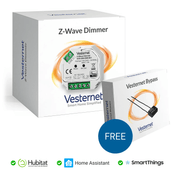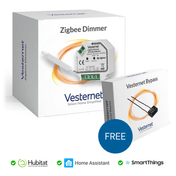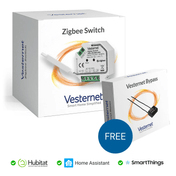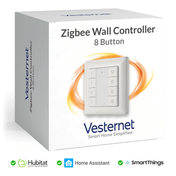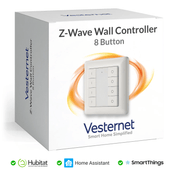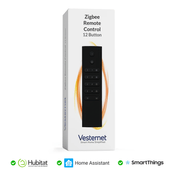Smart motion sensors have become essential for modern home automation, but choosing between basic motion detection and advanced light-sensing capabilities can be challenging for homeowners seeking optimal automation performance. The decision between reliable Zigbee connectivity and cutting-edge Matter protocol support can significantly impact your long-term smart home success.
This comprehensive comparison will help you decide between Aqara's P1 and P2 motion sensors, examining their detection capabilities, protocol support, and automation potential to find your perfect smart home match. We'll explore how each sensor handles motion detection, integrates with popular platforms like Alexa motion detection systems, and supports various automation scenarios.
As a leading UK smart home specialist, Vesternet has extensively tested both sensors in real-world scenarios, giving you expert insights to make an informed purchasing decision that aligns with your specific automation needs and technical requirements.

Understanding the Aqara Motion Sensor P1's Zigbee-Powered Detection
The Aqara Motion Sensor P1 delivers reliable motion detection through proven Zigbee 3.0 technology, offering homeowners a straightforward solution for basic automation needs. This sensor combines motion sensing with basic light state detection, creating a versatile foundation for smart home routines without overwhelming complexity.
Key P1 Features
- Configurable detection timeout from 1 to 200 seconds for energy efficiency
- Adjustable 170° field of view covering up to 7 metres detection range
- Three sensitivity modes (high, medium, low) for customised detection distance
- 360° adjustable stand for precise positioning and optimal coverage
The P1's Zigbee 3.0 connectivity ensures stable communication with compatible hubs, making it an excellent choice for established smart home ecosystems. Its configurable timeout settings allow you to balance responsiveness with battery conservation, adapting to your specific room usage patterns and automation preferences.

Exploring the Aqara P2's Matter-Enabled Dual Sensor Technology
The Aqara Motion and Light Sensor P2 represents a significant advancement in smart sensor technology, featuring independent light sensing capabilities alongside motion detection. This dual-sensor approach enables more sophisticated automations based on both movement and ambient lighting conditions, perfect for advanced smart home enthusiasts.
Advanced P2 Capabilities
- Independent light sensor for precise brightness-based automations
- Matter protocol support ensuring broad platform compatibility
- Extended 2-year battery life with dual CR2450 lithium batteries
- Privacy-conscious design suitable for bedrooms and bathrooms
The P2's Matter support positions it as a future-proof investment, offering seamless integration across different smart home platforms without requiring specific hub limitations. Its dedicated light sensor opens up automation possibilities that standard motion sensors simply cannot achieve, from curtain control based on natural light levels to sophisticated lighting scenes.
Protocol Support and Smart Home Integration Capabilities
Protocol choice fundamentally impacts your sensor's compatibility and integration flexibility within existing smart home ecosystems. The P1's Zigbee 3.0 connectivity offers proven reliability and extensive device compatibility, whilst the P2's Matter support represents the newest standard for cross-platform interoperability.
Zigbee 3.0 Benefits (P1)
- Established mesh networking for enhanced signal reliability
- Wide compatibility with existing Zigbee hubs and controllers
- Lower latency communication for responsive automation triggers
- Mature ecosystem with extensive third-party device support
Zigbee's mesh networking capabilities ensure that your motion sensor maintains consistent connectivity even in challenging wireless environments. This protocol excels in homes with multiple Zigbee devices, creating a self-healing network that automatically routes signals around obstacles or interference.
Matter Protocol Advantages (P2)
- Universal compatibility across Apple HomeKit, Google Home, and Alexa motion detection systems
- Future-proof connectivity eliminating platform lock-in concerns
- Enhanced security features with built-in encryption protocols
- Simplified setup process across different smart home platforms
Matter's universal approach means the P2 can integrate seamlessly with multiple platforms simultaneously, offering unprecedented flexibility for mixed-ecosystem households. This connectivity standard particularly benefits users seeking home assistant ble presence detection alongside traditional motion sensing, providing comprehensive monitoring capabilities across different automation platforms.
Integration complexity varies significantly between protocols, with Zigbee requiring compatible hub infrastructure whilst Matter often enables direct device-to-platform communication. Consider your existing setup and future expansion plans when evaluating protocol compatibility, as this decision will influence your sensor's long-term utility and upgrade potential.
Real-World Detection Accuracy and Response Times
Motion detection performance directly impacts automation reliability, making accuracy and response times critical factors in sensor selection. Both sensors deliver impressive detection capabilities, but their performance characteristics differ in ways that may influence your specific application requirements.
Detection Performance Comparison
- P1: 170° coverage up to 7 metres with configurable sensitivity levels
- P2: Enhanced 170° detection with improved precision algorithms
- Response times: Both sensors achieve sub-second motion detection
- False positive rates: P2 shows marginally better discrimination accuracy
The P1's three sensitivity modes provide flexibility for different room sizes and usage patterns, allowing you to reduce false triggers in high-traffic areas or increase sensitivity for subtle movement detection. Its configurable timeout settings help balance battery life with responsiveness, particularly important in frequently used spaces like hallways or kitchens.
The P2's advanced hardware design incorporates improved detection algorithms that enhance accuracy whilst maintaining excellent coverage. Its independent light sensor adds contextual awareness that can improve automation logic, reducing unnecessary activations during bright daylight hours when artificial lighting isn't needed.
Environmental Considerations
- Temperature sensitivity: Both sensors perform reliably in typical indoor conditions
- Light interference: P2's dedicated light sensor provides superior ambient light handling
- Installation flexibility: Both offer adjustable mounting for optimal positioning
Real-world testing reveals consistent performance from both sensors across various room types and conditions. The P2's enhanced precision particularly shines in complex environments where traditional motion sensors might struggle with accuracy, making it ideal for sophisticated automation scenarios requiring reliable detection consistency.
Aqara P1 Strengths and Limitations for Smart Home Users
The P1 excels as a reliable, straightforward motion sensor that delivers consistent performance without unnecessary complexity. Its configurable timeout and sensitivity settings provide sufficient customisation for most automation scenarios, whilst maintaining user-friendly operation that appeals to smart home beginners.
P1 Advantages
- Cost-effective solution for basic motion detection needs
- Proven Zigbee 3.0 reliability with extensive ecosystem support
- Simple setup and configuration through Aqara Home app
- Versatile mounting options with 360° adjustable stand
The sensor's Zigbee connectivity integrates smoothly with existing smart home hubs, particularly benefiting users with established Zigbee networks. Its basic light state detection provides sufficient functionality for simple day/night automation routines without the complexity of independent light sensing.
P1 Limitations
- Requires compatible Zigbee hub for operation
- Limited light sensing compared to dedicated light sensors
- Protocol lock-in may limit future platform flexibility
Whilst the P1's hub requirement might seem restrictive, it often provides better integration stability within established Zigbee ecosystems. Users should consider whether their current setup supports Zigbee devices and whether they're comfortable with platform-specific automation capabilities rather than universal compatibility.
Aqara P2 Benefits and Potential Drawbacks for Homeowners
The P2 represents advanced sensor technology with independent light sensing capabilities that enable sophisticated automation scenarios impossible with traditional motion sensors. Its Matter protocol support ensures broad compatibility whilst delivering enhanced functionality for demanding smart home applications.
P2 Advantages
- Independent light sensor enables precise brightness-based automations
- Matter support provides universal platform compatibility
- Extended 2-year battery life reduces maintenance requirements
- Privacy-conscious design suitable for sensitive areas
The dual-sensor approach opens automation possibilities that single-function devices cannot achieve, from intelligent curtain control to sophisticated lighting scenes that respond to both occupancy and natural light levels. This capability particularly benefits users seeking advanced home assistant ble presence detection integration alongside traditional motion sensing.
P2 Considerations
- Higher complexity may overwhelm users seeking basic functionality
- Advanced features require compatible automation platforms
- Matter ecosystem still developing compared to established protocols
Whilst the P2's advanced capabilities offer significant benefits, users primarily needing simple motion detection might find its additional features unnecessary. The sensor's sophisticated functionality requires automation platforms capable of leveraging dual-sensor inputs, potentially limiting its appeal for basic smart home setups seeking straightforward motion-triggered responses.
Choosing Your Ideal Motion Sensor Based on Smart Home Needs
Selecting the right motion sensor depends on your specific automation requirements, existing platform compatibility, and future smart home expansion plans. Understanding your priorities helps identify which sensor's strengths align with your particular use cases and technical environment.
Choose the P1 If You Need
- Reliable basic motion detection for lighting and security automation
- Cost-effective sensor integration within existing Zigbee ecosystems
- Simple configuration without advanced feature complexity
- Proven compatibility with established smart home platforms
The P1 suits homeowners seeking dependable motion sensing without advanced complexity, particularly those with established Zigbee networks requiring straightforward sensor expansion. Its configurable settings provide sufficient customisation for most residential automation scenarios whilst maintaining user-friendly operation.
Select the P2 For Advanced Requirements
- Independent light-based automation alongside motion detection
- Universal Matter compatibility across multiple platforms
- Future-proof connectivity avoiding platform lock-in concerns
- Sophisticated automation scenarios requiring dual-sensor inputs
Advanced users benefit from the P2's dual-sensor capabilities, particularly those implementing complex automation logic that considers both occupancy and lighting conditions. Its Matter support appeals to multi-platform households or users planning significant smart home expansion across different ecosystems.
Consider your current smart home infrastructure, automation complexity preferences, and budget constraints when making your selection. The P1 provides excellent value for straightforward motion detection needs, whilst the P2 offers advanced capabilities that justify its position as a premium sensor solution.
Integration Scenarios
- Basic automation: P1 handles simple on/off lighting and security alerts effectively
- Advanced scenes: P2 enables complex routines combining motion, light, and time factors
- Multi-platform: P2's Matter support benefits diverse ecosystem requirements
- Alexa motion detection: Both sensors integrate well with voice assistant platforms
Evaluate your specific room requirements and automation goals to determine which sensor's capabilities align with your smart home vision. Both options deliver reliable performance within their respective feature sets, ensuring successful integration regardless of your choice.
Making Your Motion Sensor Decision
Both the Aqara P1 and P2 motion sensors excel in different scenarios, with the P1 offering reliable basic motion detection through proven Zigbee connectivity, whilst the P2 provides advanced dual-sensor capabilities with future-proof Matter support. Each sensor delivers consistent performance within its intended scope, ensuring successful smart home integration.
The superior choice depends entirely on your individual smart home requirements, existing platform preferences, and desired automation complexity levels. Consider whether you prioritise cost-effective basic functionality or advanced sensing capabilities that enable sophisticated automation scenarios beyond simple motion detection.
Before making your final decision, assess your specific needs including protocol compatibility with existing devices, light-based automation requirements, and long-term smart home expansion plans. Factor in your comfort level with advanced features versus preference for straightforward operation that focuses on essential motion sensing functionality.
Ready to enhance your smart home automation? Explore both the Aqara Motion Sensor P1 and the Aqara Motion and Light Sensor P2 in Vesternet's collection to discover which sensor perfectly matches your automation needs and technical requirements.










